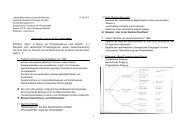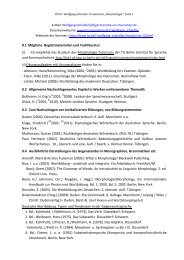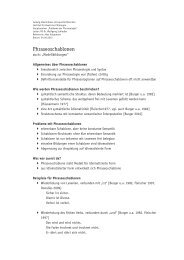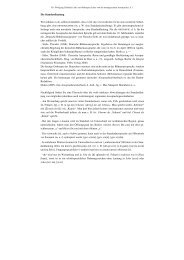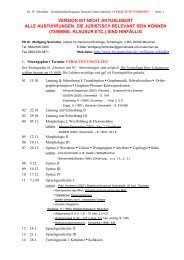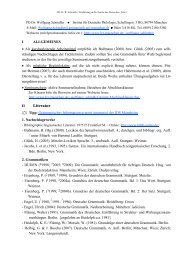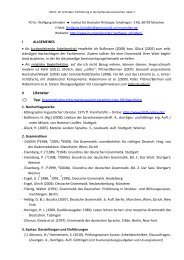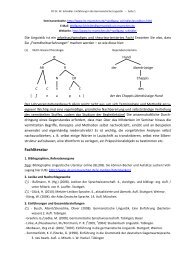Chapter 18 Lexical Functions: Description of Lexical Relations in a ...
Chapter 18 Lexical Functions: Description of Lexical Relations in a ...
Chapter 18 Lexical Functions: Description of Lexical Relations in a ...
You also want an ePaper? Increase the reach of your titles
YUMPU automatically turns print PDFs into web optimized ePapers that Google loves.
—<strong>Chapter</strong> <strong>18</strong>. <strong>Lexical</strong> <strong>Functions</strong>— 62<br />
lit. (justifies itself) daetsja lit. (confirms itself)<br />
Rus. Fact 0(mečta (dream)) = sbyvaetsja lit. (realizes itself)<br />
ContFact 0(luck) = holds Rus. ContFact 1(udača (luck)) = ne pokidaet [NXacc]<br />
lit. (does not abandon)<br />
Labreal 12(saw) = cut [NY with ART ~] //saw [NY]<br />
Labreal 12(gallows) = str<strong>in</strong>g up [NY on ART ~], hang [NY from ART ~]<br />
Labreal 12(asphalt) = cover [NY with ~] //asphalt [NY]<br />
The LFs 55-64 express new situations related to the situation referred to by the keyword L.<br />
55. Involv [Lat. <strong>in</strong>volvere (drag along)] = <strong>in</strong>volvement verb<br />
L´ = Involv(L) is a verb mean<strong>in</strong>g (<strong>in</strong>volve Y), (concern Y); it l<strong>in</strong>ks L and the name <strong>of</strong> a<br />
non-participant Y which is affected or acted upon by the situation (L); Y is DSyntA II <strong>of</strong> Involv,<br />
and L (= the keyword), its DSyntA I.<br />
Examples<br />
Involv(light) = floods [NY, e.g. the room]<br />
Involv(snowstorm) = catches [Nhum-Y Loc<strong>in</strong> N; e.g. … caught John <strong>in</strong> the woods],<br />
hits [N area -Y; e.g., Then the snowstorm hit!, where hit = IncepFunc 0 ]<br />
Involv(explosion) = rocks [NY, e.g. the build<strong>in</strong>g]<br />
Involv(river) = floods [NY, e.g. the area]<br />
AntiBon 1Involv(car) = smashes [<strong>in</strong>to NY, e.g. a telephone pole]<br />
AntiBon 2Involv(car) = hits, runs over, strikes [NY, e.g. a pedestrian]<br />
56. Manif [Lat. manifestāre (manifest)] = manifestation verb<br />
Manif is a verb mean<strong>in</strong>g (L manifests itself [≈ becomes apparent] <strong>in</strong> Y). The keyword L, a<br />
noun, is DSyntA I <strong>of</strong> Manif, and Y (= <strong>in</strong> which L manifests itself), its DSyntA II.<br />
Examples<br />
Manif(distrust) = lurks [<strong>in</strong> Andrew’s eyes]<br />
Manif(joy) = explodes [<strong>in</strong> them]<br />
Manif(scorn) = is dripp<strong>in</strong>g [from every word]<br />
Caus 1Manif(gratitude) = express, show [NX’s ~]<br />
Caus 1Manif(relief) = heave a sigh [<strong>of</strong> ~]


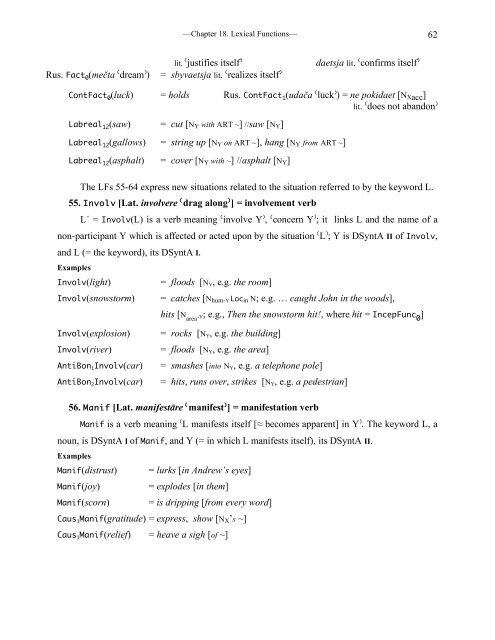
![E-Mail: Wolfgang.Schindler[ätt]germanistik.uni-muenchen.de Web ...](https://img.yumpu.com/51590147/1/184x260/e-mail-wolfgangschindlerattgermanistikuni-muenchende-web-.jpg?quality=85)
